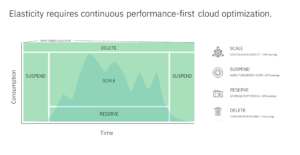
Hybrid cloud has become the new normal for enterprises in nearly all industries. Many enterprises have also deployed a hybrid multicloud environment that’s reliant on an ecosystem of different cloud service providers.
71% of executives think it’s difficult to realize the full potential of a digital transformation without having a solid hybrid cloud strategy in place. [1]
Managing complex business operations across a hybrid multicloud environment presents leaders with unique challenges, not least of which are cyberthreats that can bring essential business functions to a halt—potentially for days, weeks or months. A robust risk management strategy that takes full advantage of an enterprise’s hybrid multicloud environment and on-premises infrastructure can neutralize those vulnerabilities and deliver business resilience while unlocking innovation.
But what does such a strategy entail? There are three keys to developing a successful hybrid cloud risk management strategy: security, compliance and resiliency.
Security: Keeping sensitive data and workloads safe
Protecting critical data amid a heightened threat landscape is top of mind for many business leaders, and for good reason. Organizations need a strong risk management strategy to be prepared when the unthinkable happens—and it will happen. Enterprises need to have response mechanisms built into their hybrid cloud environment to get the business back to business, fast.
The global average cost of a single data breach is USD 4.45 million. [2]
Adopting a hybrid cloud approach to risk mitigation can assure an enterprise’s IT and security leaders are able to keep sensitive data and workloads safe from cyberattacks that can occur anywhere, anytime. Leaders need technical assurance that private workloads, data and access keys remain in the exclusive control of authorized users at all times.
Compliance: Keeping the regulators at bay
Noncompliance is a nonstarter in regulated industries. Between 2020 and 2022, the financial services sector saw “fines in excess of 75 million US dollars in response to IT and cloud-specific failures” levied against major banks. [3] To avoid these extraordinary costs, enterprises need to build capabilities that ensure compliance with changing regulations in all the places they do business.
The cost of a data breach at organizations with high levels of noncompliance is 12.6% higher. [2]
Failure to act isn’t an option. IBM’s cloud solutions feature built-in controls and continuous compliance to address business leaders’ security and compliance concerns.
Resiliency: Keeping the business running
Keeping the business up and running must be the primary consideration of any hybrid cloud risk management strategy—building resilience into the IT environment to help ensure seamless business operations and unfettered innovation. Leaders must ensure their hybrid cloud risk strategy encompasses the tools needed to quickly respond to disruptions and fully recover all data that’s been compromised.
Learn more
IBM offers several storage and recovery products that enhance an enterprise’s ability to bounce back from disruptions to keep business running for their clients. And they do so at scale across hybrid cloud and on-premises infrastructure.
Every hour IT teams spend recovering critical data is time not spent developing new products and solutions. Done right, a robust hybrid cloud risk management strategy can provide elevated assurances around security, compliance and resilience while fostering the continuous innovation that underpins a successful business.
Read more on how to make business resilience the new norm
[1] The new era of cloud security, IBM Institute for Business Value, 23 March 2021.
[2] Cost of a Data Breach Report 2023, IBM Security®, July 2023.
[3] Ray Strecker, James Pastro and Charlie Edison, “Regulators Are Focused on Cloud Risk Management,” Promontory Currents, 5 April 2023.
More from Cloud

October 24, 2023
Enterprise-managed IAM: An SRE team case study
5 min read – Enterprise-managed identity and access management (IAM) enables cloud administrators to centrally configure access and security settings for the entire organization. To learn about the basics, see “How enterprise-managed IAM works.” The case study in this blog post shows how to easily and securely implement and manage a site reliability engineering (SRE) team’s access across an enterprise. Case study A large banking client has a centralized site reliability engineering (SRE) team that manages operations for all resources in the organization. The…
<!—->

October 18, 2023
IBM Cloud Databases version End-of-Life announcement
2 min read – IBM Cloud Databases is announcing the End of Life on the following database versions on April 26, 2024: IBM Cloud Databases for MySQL v5.7 IBM Cloud Databases for Elasticsearch v7.17 IBM Cloud Databases for MongoDB v4.4 IBM Cloud Databases for Redis v5.0 IBM Cloud Databases for etcd v3.3 On April 26, 2024, support for the above versions ends. Next steps IBM recommends that customers upgrade their database deployments to the next supported version. Our recommended procedure for this is restoring…
<!—->

October 16, 2023
Living in a data sovereign world
7 min read – As the world continues to become a globally connected ecosystem, data fluidity has sparked national and international conversations around notions of data and digital sovereignty. While these concepts are still emerging, many countries are developing laws and regulations to deal with the boundless nature of data, and the global and multinational organizations that are creating, housing, and distributing them. What do organizations need to do to in order to operate under these new sovereignty concepts? First, we must understand how…
<!—->

October 16, 2023
Announcing the deprecation of prior generation Db2 Warehouse plans on AWS
2 min read – We recently launched the next generation of IBM Db2 Warehouse on AWS. This new generation brings a host of new capabilities, including support for cloud object storage (Amazon S3), open data and table formats, and integration with IBM watsonx.data. Learn more here. As a result, we will end support for the prior generation Db2 Warehouse plans on AWS. Affected plans Db2 Warehouse Flex on AWS Db2 Warehouse Flex Performance on AWS Starting today, you will no longer be able to…
<!—->
IBM Newsletters
Get our newsletters and topic updates that deliver the latest thought leadership and insights on emerging trends.
Subscribe now More newsletters
- SEO Powered Content & PR Distribution. Get Amplified Today.
- PlatoData.Network Vertical Generative Ai. Empower Yourself. Access Here.
- PlatoAiStream. Web3 Intelligence. Knowledge Amplified. Access Here.
- PlatoESG. Carbon, CleanTech, Energy, Environment, Solar, Waste Management. Access Here.
- PlatoHealth. Biotech and Clinical Trials Intelligence. Access Here.
- Source: https://www.ibm.com/blog/3-keys-to-building-a-robust-hybrid-cloud-risk-strategy/
- :has
- :is
- :not
- $UP
- 06
- 1
- 12
- 16
- 17
- 2020
- 2021
- 2022
- 2023
- 2024
- 23
- 24
- 26
- 28
- 29
- 30
- 300
- 33
- 36
- 40
- 400
- 41
- 67
- 7
- 75
- 9
- a
- ability
- Able
- About
- above
- access
- access management
- across
- Act
- address
- administrators
- ADvantage
- Advertising
- affected
- against
- All
- also
- Amazon
- Amid
- amp
- an
- analytics
- and
- Announcement
- Announcing
- any
- anywhere
- approach
- April
- ARE
- around
- article
- AS
- assurance
- assure
- At
- author
- authorized
- average
- avoid
- AWS
- back
- Banking
- Banks
- Basics
- BE
- become
- been
- between
- Blog
- blogs
- Bounce
- Boundless
- breach
- bring
- Brings
- build
- Building
- built
- built-in
- business
- business functions
- Business Leaders
- business operations
- button
- by
- CAN
- capabilities
- carbon
- card
- Cards
- case
- case study
- CAT
- Category
- centralized
- challenges
- changing
- Charlie
- check
- CIS
- City
- class
- client
- clients
- Cloud
- color
- complex
- compliance
- Compromised
- computer
- concepts
- Concerns
- connected
- consideration
- Container
- continue
- continues
- continuous
- control
- controls
- conversations
- Cost
- Costs
- countries
- Creating
- critical
- CSS
- CTO
- custom
- Customers
- cyberthreats
- data
- data breach
- Database
- databases
- Date
- Days
- deal
- Default
- definitions
- deliver
- deployed
- deployments
- description
- developing
- different
- difficult
- digital
- Digital Transformation
- disruptions
- distributing
- do
- does
- dollars
- done
- dr
- drone
- easily
- ecosystem
- Edison
- Elasticsearch
- elevated
- emerging
- enables
- encompasses
- end
- ends
- Engineering
- enhance
- ensure
- Enter
- Enterprise
- enterprises
- Entire
- Environment
- Era
- essential
- Ether (ETH)
- excess
- Exclusive
- executives
- Exit
- extraordinary
- FAST
- Feature
- fellow
- financial
- financial services
- First
- fluidity
- focused
- follow
- following
- fonts
- For
- fostering
- from
- full
- fully
- functions
- generation
- generator
- get
- Global
- Globally
- good
- Grid
- happen
- Have
- having
- Heading
- height
- heightened
- help
- here
- High
- higher
- host
- hour
- housing
- How
- How To
- HTTPS
- Hybrid
- hybrid cloud
- IAM
- IBM
- IBM Cloud
- ICO
- ICON
- Identity
- identity and access management
- Identity and Access Management (IAM)
- image
- implement
- in
- Including
- index
- industries
- Infrastructure
- Innovation
- insights
- Institute
- integration
- International
- into
- IT
- james
- July
- Keep
- keeping
- keys
- landscape
- large
- latest
- launched
- Laws
- Laws and regulations
- leaders
- Leadership
- LEARN
- least
- levels
- Life
- living
- local
- locale
- longer
- major
- make
- man
- manage
- management
- manages
- many
- March
- max-width
- mechanisms
- million
- min
- mind
- minutes
- mitigation
- Mobile
- MongoDB
- months
- more
- multinational
- must
- MySQL
- National
- Nature
- Navigation
- nearly
- Need
- needed
- New
- new products
- Newsletters
- next
- no
- normal
- nothing
- now
- object
- Object Storage
- occur
- october
- of
- Offers
- on
- open
- open data
- operate
- Operations
- optimized
- Option
- or
- order
- organization
- organizations
- our
- page
- People
- performance
- PHP
- Place
- Places
- plans
- plato
- Plato Data Intelligence
- PlatoData
- plugin
- policy
- position
- Post
- potential
- prepared
- presents
- primary
- Prior
- private
- procedure
- Products
- provide
- providers
- quickly
- RAY
- Reading
- realize
- reason
- recently
- recommended
- recommends
- Recover
- recovering
- recovery
- regulated
- regulated industries
- regulations
- Regulators
- reliability
- remain
- report
- resilience
- Resources
- Respond
- response
- responsive
- result
- right
- Risk
- risk management
- Risk Mitigation
- road
- robots
- robust
- Room
- running
- s
- safe
- saw
- Scale
- Screen
- scripts
- seamless
- sector
- securely
- security
- see
- sensitive
- seo
- server
- service
- service providers
- Services
- settings
- several
- shot
- Shows
- single
- site
- small
- So
- solid
- Solutions
- sovereign
- sovereignty
- sparked
- spend
- spent
- Sponsored
- start
- Starting
- Steps
- Still
- storage
- Strategy
- strong
- Study
- subscribe
- successful
- such
- support
- Supported
- table
- takes
- team
- teams
- Technical
- tertiary
- that
- The
- The Basics
- the world
- their
- Them
- theme
- There.
- These
- they
- think
- this
- those
- thought
- thought leadership
- threat
- three
- time
- times
- Title
- to
- today
- tools
- top
- topic
- Transformation
- Trends
- type
- under
- understand
- unique
- unlocking
- unthinkable
- Updates
- upgrade
- URL
- us
- US Dollars
- USD
- users
- value
- version
- Vulnerabilities
- W
- Warehouse
- we
- Weeks
- What
- when
- which
- while
- will
- with
- without
- WordPress
- works
- world
- written
- you
- zephyrnet












